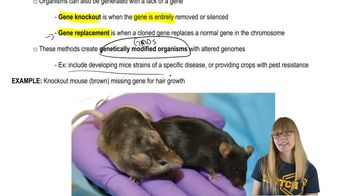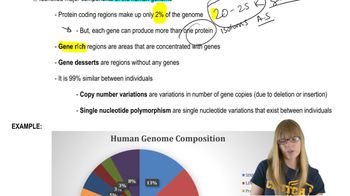Table of contents
- 1. Introduction to Genetics51m
- 2. Mendel's Laws of Inheritance3h 37m
- 3. Extensions to Mendelian Inheritance2h 41m
- 4. Genetic Mapping and Linkage2h 28m
- 5. Genetics of Bacteria and Viruses1h 21m
- 6. Chromosomal Variation1h 48m
- 7. DNA and Chromosome Structure56m
- 8. DNA Replication1h 10m
- 9. Mitosis and Meiosis1h 34m
- 10. Transcription1h 0m
- 11. Translation58m
- 12. Gene Regulation in Prokaryotes1h 19m
- 13. Gene Regulation in Eukaryotes44m
- 14. Genetic Control of Development44m
- 15. Genomes and Genomics1h 50m
- 16. Transposable Elements47m
- 17. Mutation, Repair, and Recombination1h 6m
- 18. Molecular Genetic Tools19m
- 19. Cancer Genetics29m
- 20. Quantitative Genetics1h 26m
- 21. Population Genetics50m
- 22. Evolutionary Genetics29m
15. Genomes and Genomics
Genomics and Human Medicine
Problem 14h
Textbook Question
How has the use of model organisms advanced our knowledge of the genes that control human diseases?
 Verified step by step guidance
Verified step by step guidance1
Model organisms, such as fruit flies (Drosophila melanogaster), mice (Mus musculus), and zebrafish (Danio rerio), have been instrumental in genetic research due to their genetic similarities to humans and their relatively simple genomes.
These organisms allow researchers to manipulate genes and observe the effects, providing insights into gene function and regulation that are often applicable to human biology.
By studying model organisms, scientists can identify genes that are conserved across species, which often play crucial roles in fundamental biological processes and can be linked to human diseases.
Model organisms enable the study of gene interactions and pathways, helping to elucidate the complex networks involved in disease mechanisms.
Research using model organisms has led to the discovery of genetic mutations and pathways that contribute to diseases, facilitating the development of targeted therapies and personalized medicine approaches for human health.
Recommended similar problem, with video answer:
 Verified Solution
Verified SolutionThis video solution was recommended by our tutors as helpful for the problem above
Video duration:
2mPlay a video:
Was this helpful?
Key Concepts
Here are the essential concepts you must grasp in order to answer the question correctly.
Model Organisms
Model organisms are non-human species that are extensively studied to understand biological processes. They are chosen for their genetic, biological, or behavioral similarities to humans, allowing researchers to investigate gene functions and disease mechanisms. Common examples include mice, fruit flies, and zebrafish, which serve as valuable tools in genetics and biomedical research.
Recommended video:
Guided course

Transgenic Organisms and Gene Therapy
Genetic Homology
Genetic homology refers to the similarity in DNA sequences between different species due to shared ancestry. This concept is crucial in model organism research, as it allows scientists to extrapolate findings from model organisms to humans. By studying genes in these organisms, researchers can identify conserved pathways and potential targets for treating human diseases.
Recommended video:
Guided course

Descriptive Genetics
Transgenic Techniques
Transgenic techniques involve the introduction of foreign DNA into an organism's genome, enabling the study of gene function and regulation. These methods allow researchers to create models that mimic human diseases, facilitating the investigation of genetic contributions to conditions such as cancer and neurodegenerative disorders. This approach has significantly advanced our understanding of disease mechanisms and potential therapeutic strategies.
Recommended video:
Guided course

Transgenic Organisms and Gene Therapy

 6:51m
6:51mWatch next
Master Human Genome Composition with a bite sized video explanation from Kylia Goodner
Start learningRelated Videos
Related Practice


